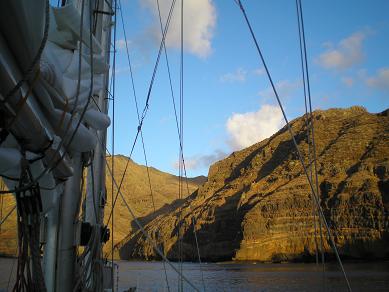Las Palmas, Gran Canaria, Canary Islands
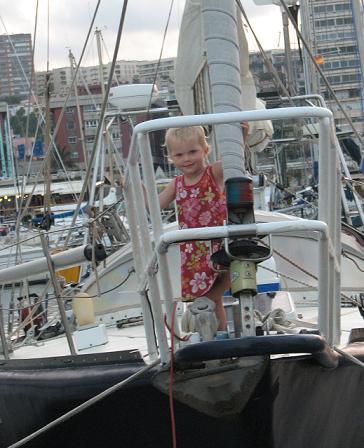 The little girl has sailed from Tunisia to the Canaries (with her parents).
The little girl has sailed from Tunisia to the Canaries (with her parents).
Monthly Archives: August 2008
Customs
Las Palmas, Gran Canaria, Canary Islands
 I ordered a new roller furler (rolls the sails up when they are not in use) from the USA. FedEx got it as far as Madrid, then it stopped there. After a week, and many phone calls to FedEx and the shipper, I was not getting anywhere. I kept getting told I needed to pay about 30% tax and provide a DNI number (an identity number—proof that I was a legal resident in the Canary Islands) to receive the shipment. Really not being fond of the idea of staying long enough in the Canary Islands to become a resident just so I could receive a FedEx package, I was starting to consider the idea of doing without the roller furler. I talked with neighbours on the dock, and they told me that a package that has gone to Madrid meant at least two weeks to get to the Canaries. I wanted to leave in less than two weeks, with the furler installed, so had a problem.As can be the case with otherwise-insolvable problems, a visit to the bar sometimes helps. There I talked to Hugh, a delivery skipper neighbor on the dock had run a charter boat operation in Gran Canaria for a few years, and understood the art of getting parts shipped in. He explained that the strategy was to get the package to the local customs people, who are easier to deal with, as you can talk to them directly. Also that “if anyone in the government speaks English, it is the customs people”. Apparently a big concern of Spanish customs with regards to Boats In Transit (boats from other countries, which are not required to pay taxes on items that will leave the country with the boat) is local people pretending to be boats in transit to avoid tax. No one who hears me attempt to speak Spanish would ever mistake me for a local. We went to the nearby Customs first, they told us to go to Customs at the airport, as it was an air shipment. Customs at the airport directed us to the Air Iberia cargo terminal, where we were further directed to the company that handles FedEx shipments (Transistos Castillanos). Senor Jesus, the very helpful agent, asked his neighbor to translate, and we described the problem. After about an hour of phone calls, Senor Jesus on one phone in Spanish, me on another phone in English, Customs in Madrid apologized for the delay, and explained it was due to the shipment not saying Boat In Transit on it. Two days later, the new furler was in Las Palmas. I rented a truck, drove to the courier company, paid some taxes (the EU charges 2.5% for whatever) and fees, and finally picked up the new furler. Now we just have to install it
I ordered a new roller furler (rolls the sails up when they are not in use) from the USA. FedEx got it as far as Madrid, then it stopped there. After a week, and many phone calls to FedEx and the shipper, I was not getting anywhere. I kept getting told I needed to pay about 30% tax and provide a DNI number (an identity number—proof that I was a legal resident in the Canary Islands) to receive the shipment. Really not being fond of the idea of staying long enough in the Canary Islands to become a resident just so I could receive a FedEx package, I was starting to consider the idea of doing without the roller furler. I talked with neighbours on the dock, and they told me that a package that has gone to Madrid meant at least two weeks to get to the Canaries. I wanted to leave in less than two weeks, with the furler installed, so had a problem.As can be the case with otherwise-insolvable problems, a visit to the bar sometimes helps. There I talked to Hugh, a delivery skipper neighbor on the dock had run a charter boat operation in Gran Canaria for a few years, and understood the art of getting parts shipped in. He explained that the strategy was to get the package to the local customs people, who are easier to deal with, as you can talk to them directly. Also that “if anyone in the government speaks English, it is the customs people”. Apparently a big concern of Spanish customs with regards to Boats In Transit (boats from other countries, which are not required to pay taxes on items that will leave the country with the boat) is local people pretending to be boats in transit to avoid tax. No one who hears me attempt to speak Spanish would ever mistake me for a local. We went to the nearby Customs first, they told us to go to Customs at the airport, as it was an air shipment. Customs at the airport directed us to the Air Iberia cargo terminal, where we were further directed to the company that handles FedEx shipments (Transistos Castillanos). Senor Jesus, the very helpful agent, asked his neighbor to translate, and we described the problem. After about an hour of phone calls, Senor Jesus on one phone in Spanish, me on another phone in English, Customs in Madrid apologized for the delay, and explained it was due to the shipment not saying Boat In Transit on it. Two days later, the new furler was in Las Palmas. I rented a truck, drove to the courier company, paid some taxes (the EU charges 2.5% for whatever) and fees, and finally picked up the new furler. Now we just have to install it 
New stay being made
Tenerife, Canary Islands
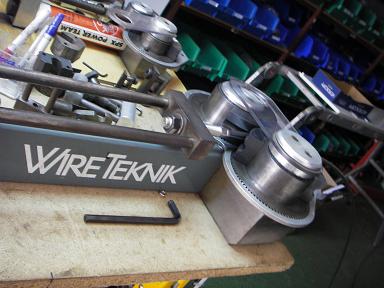 End being put on new stay (wire). Hydraulic cylinder (to the left of the photo) pulls the end fitting through the circular dies which press fit it onto the wire. It results in a very strong end to the wire, but not something that can be changed, or done at sea (there are other types of fittings that allow you to put ends on with wrenches). This stay (wire) is being made to replace the wire that one old roller furling unit was on. It is a good idea to replace the wires when the roller furlers are replaced, since you can’t inspect the wires after you put a roller furler on them.
End being put on new stay (wire). Hydraulic cylinder (to the left of the photo) pulls the end fitting through the circular dies which press fit it onto the wire. It results in a very strong end to the wire, but not something that can be changed, or done at sea (there are other types of fittings that allow you to put ends on with wrenches). This stay (wire) is being made to replace the wire that one old roller furling unit was on. It is a good idea to replace the wires when the roller furlers are replaced, since you can’t inspect the wires after you put a roller furler on them.
Rigging Shop
Tenerife, Canary Islands
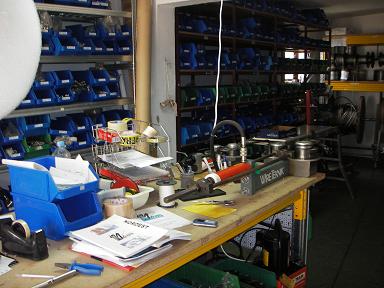 Rigging shop in Tenerife. The hydraulic machine that presses the ends onto the wires is the one that says Wire Teknik on it.
Rigging shop in Tenerife. The hydraulic machine that presses the ends onto the wires is the one that says Wire Teknik on it.
Comfortable travel
Canary Islands
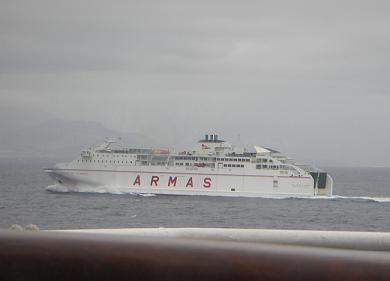 In order to get a new stay (wire) made for the roller furling unit I am replacing, I had to go to Tenerife to get it made. I first tried getting it done via email and phone, but quickly realized that between the language barrier and not being sure exactly who would make the wire (the length and type of fittings are critical), it was better to go in person to be sure to get one that would fit. I’ve made the sail on Issuma from Las Palmas to Tenerife and back a few times. It tends to take about 12 hours, port to port. Today I took this ferry (actually, I took a picture of this ferry from its sistership, which I am aboard), which only takes a little over 3 hours. I have to admit it is much more comfortable to travel by ferry :). This one has a bar, TV, comfortable chairs, and someone else to wash the windows and do all the navigating :). Not nearly as much fun as sailing, though.
In order to get a new stay (wire) made for the roller furling unit I am replacing, I had to go to Tenerife to get it made. I first tried getting it done via email and phone, but quickly realized that between the language barrier and not being sure exactly who would make the wire (the length and type of fittings are critical), it was better to go in person to be sure to get one that would fit. I’ve made the sail on Issuma from Las Palmas to Tenerife and back a few times. It tends to take about 12 hours, port to port. Today I took this ferry (actually, I took a picture of this ferry from its sistership, which I am aboard), which only takes a little over 3 hours. I have to admit it is much more comfortable to travel by ferry :). This one has a bar, TV, comfortable chairs, and someone else to wash the windows and do all the navigating :). Not nearly as much fun as sailing, though.
Busy Repair Port
Las Palmas, Gran Canaria, Canary Islands
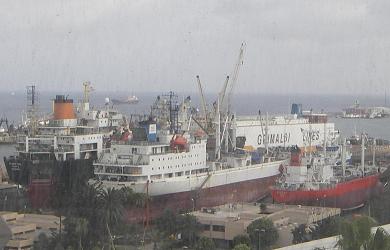 We are not the only boat doing a lot of repairs and maintenance in Las Palmas…there are several ships in dry dock. The advantage of being in a port with a ship repair industry is that a lot of materials and equipment are available. The disadvantage of doing it here is that parts that need to be ordered from overseas can be quite difficult (more on this later).
We are not the only boat doing a lot of repairs and maintenance in Las Palmas…there are several ships in dry dock. The advantage of being in a port with a ship repair industry is that a lot of materials and equipment are available. The disadvantage of doing it here is that parts that need to be ordered from overseas can be quite difficult (more on this later).
Water tank vents
Las Palmas, Gran Canaria, Canary Islands
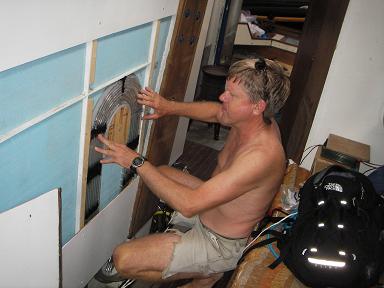 George putting in place a new water tank vent system. Issuma has nine stainless steel water tanks connected by four valves (several hundred litres in total). The vents for these tanks were all joined at the same level, then they went up to the deck. This seemed to cause a lot of confusion when filling the tanks, as water pouring out the vent hose was not an indication that the tanks were actually full. It meant only that one tank was full enough to overflow into the vent line and make the others appear to be full, and we would try to force water into the tanks under pressure until we guessed that enough was spilling out to indicate the tanks were likely full. When we first filled the tanks, we stopped filling them whenever we saw water coming out the vent line. At the time, we did not realize this meant that we had not actually filled the tanks. On our first trip with Issuma, we were headed for the Azores (from France), but ran low on water after several days and went to Spain instead. We are hoping that this new water tank vent system, with each tank having a separate vent line will allow us to definitively know when each tank is full (the tanks do not have gauges and there are too many to want to install gauges). The vents are now inside the boat, close to where the water tank valves are, which should make it easier to check when filling the tanks.
George putting in place a new water tank vent system. Issuma has nine stainless steel water tanks connected by four valves (several hundred litres in total). The vents for these tanks were all joined at the same level, then they went up to the deck. This seemed to cause a lot of confusion when filling the tanks, as water pouring out the vent hose was not an indication that the tanks were actually full. It meant only that one tank was full enough to overflow into the vent line and make the others appear to be full, and we would try to force water into the tanks under pressure until we guessed that enough was spilling out to indicate the tanks were likely full. When we first filled the tanks, we stopped filling them whenever we saw water coming out the vent line. At the time, we did not realize this meant that we had not actually filled the tanks. On our first trip with Issuma, we were headed for the Azores (from France), but ran low on water after several days and went to Spain instead. We are hoping that this new water tank vent system, with each tank having a separate vent line will allow us to definitively know when each tank is full (the tanks do not have gauges and there are too many to want to install gauges). The vents are now inside the boat, close to where the water tank valves are, which should make it easier to check when filling the tanks.
New Dinghy
Las Palmas, Gran Canaria, Canary Islands
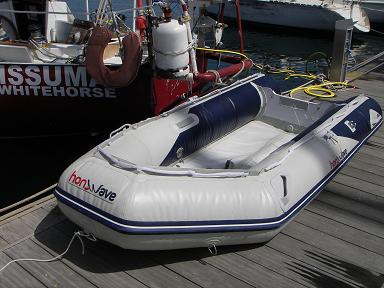 We have a new dinghy now. Much as I like rowing dinghies, the Dark Dinghy (which folds for easy storage) is not the easiest dinghy to row. A stiffer (non-folding) and heavier dinghy would row better, but I haven’t seen any really good rowing dinghies in the parts of Europe I’ve been to. So I bought an inflatable with an outboard engine (not shown) from another cruiser. This inflatable dinghy, made in China, sold in Portugal by Honda, uses unusual Florida-made valves, for which pumps are hard to find (which is why it is not fully inflated in the picture). I’m working on getting a pump adapted to fit the valves. There is a very sad story associated with this dinghy. The fibreglass ketch it was from belonged to a couple of Dutch guys who had been here in Las Palmas for a while, and recently left for Puerto Mogan (south part of this island), Cape Verde and Brazil. Their first day out, two miles off the Gran Canaria shore, black smoke began pouring out from down below and, after trying unsuccessfully to fight the fire, they escaped in the dinghy and the fibreglass ketch sank. It is not known what caused the fire, though something related to a recent engine replacement was suspected. The water is too deep for diving, so they will never know. They found themselves on a beach with a dinghy and motor and not much else, and when they got back to Las Palmas, wanted to sell the dinghy. We’ve done a lot of things to Issuma to protect against fire (replaced all the fire extinguishers, fireproofed the engine compartment, added fuses to the main wires off the batteries), due to stories like this one.
We have a new dinghy now. Much as I like rowing dinghies, the Dark Dinghy (which folds for easy storage) is not the easiest dinghy to row. A stiffer (non-folding) and heavier dinghy would row better, but I haven’t seen any really good rowing dinghies in the parts of Europe I’ve been to. So I bought an inflatable with an outboard engine (not shown) from another cruiser. This inflatable dinghy, made in China, sold in Portugal by Honda, uses unusual Florida-made valves, for which pumps are hard to find (which is why it is not fully inflated in the picture). I’m working on getting a pump adapted to fit the valves. There is a very sad story associated with this dinghy. The fibreglass ketch it was from belonged to a couple of Dutch guys who had been here in Las Palmas for a while, and recently left for Puerto Mogan (south part of this island), Cape Verde and Brazil. Their first day out, two miles off the Gran Canaria shore, black smoke began pouring out from down below and, after trying unsuccessfully to fight the fire, they escaped in the dinghy and the fibreglass ketch sank. It is not known what caused the fire, though something related to a recent engine replacement was suspected. The water is too deep for diving, so they will never know. They found themselves on a beach with a dinghy and motor and not much else, and when they got back to Las Palmas, wanted to sell the dinghy. We’ve done a lot of things to Issuma to protect against fire (replaced all the fire extinguishers, fireproofed the engine compartment, added fuses to the main wires off the batteries), due to stories like this one.
Rain
Las Palmas, Gran Canaria, Canary Islands
It rained today! It may sound odd to mention but I’ve been in the Canary Islands for two months now, and today is the first time it has rained. It only rained a millimeter or two, and its not the kind of rain that makes you want to put on a raincoat, but it was quite unusual to hear the rain and see the deck wet with anything other than salt water. The air here mostly comes from the Sahara, and doesn’t spend long enough over the sea to pick up a lot of moisture. So it is generally hot and sunny here, and hardly ever rains. Brittany has departed for adventures ashore in Turkey and New York, and is missed greatly. George and I have been working on a lot of repairs and modifications. George does the vast majority of the work while I spend much of my time chasing down obscure parts in various ferreterias (hardware stores) with my very limited Spanish. Among other things, we’ve added a new cleat to make the mainsheet easier to handle, replaced the mainsail cover, replaced the main halyard winch with a self-tailing one, overhauled many of the winches and replaced many lights with LED lights (which take less power). One of the roller furlers died (the bearings inside broke, and replacements are no longer available), and we are waiting for a new unit to replace it with.
Punta de Antiquera
